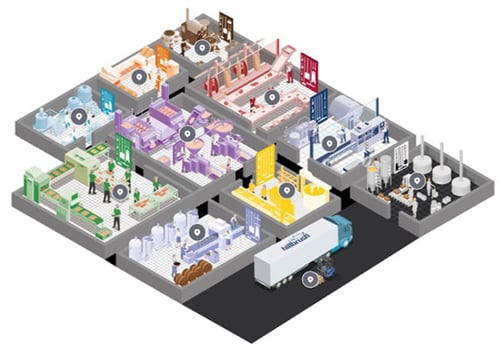Colour coding tools have become an essential part of good manufacturing practices in the food and beverage industry. They have been proven to support segregation, improve visual cleaning standards, and aid in the identification of foreign bodies caused by wear and tear of cleaning and food contact tools.
By using tools with matching-coloured handles and heads, they can be identified quickly and easily. This is especially important in workplaces where multiple languages are spoken, as it greatly aids in the training of staff.
Segregation of activities is particularly important when managing different levels of risk within manufacturing operations (high level, high care, and low risk); manufacturing of allergens and non-allergen containing products; cross-contamination routes related to the usage of equipment for cleaning and handling products; and specific hazards. A methodical colour coded approach associates each product with a particular area, promoting inter-departmental and/or food-type segregation.
The majority of our hygiene range is colour coded, with up to twelve vibrant, easily identifiable colours to choose from.
 HACCP Explained
HACCP Explained
Developed by the US National Aeronautics and Space Administration (NASA) in the 1960s, the Hazard Analysis and Critical Control Points (HACCP) initiative was created to ensure a supply of crumb and pathogen-free food for astronauts, ensuring food had a suitable shelf life to aid their survival during space travel.
This model was extremely successful, and in the 1970s, it was introduced to food manufacturers in the USA, as well as becoming part of FDA inspectors’ training. The HACCP hazard management model reached Europe in the 1980s via the World Health Organisation Europe.
Further developments to the model took place to reach the 7 principles in use today, assisting food processors and food service companies in incorporating a preventative system to identify hazards that may exist within its operations, nominating Critical Control Points to ensure suitable monitoring, and a plan of action if things go wrong, in time to avoid harm to consumers’ health.
The seven key principles of HACCP are:
- Conduct an analysis of hazards
- Determine the Critical Control Points
- Establish critical limits
- Set up a monitoring system for CCPs
- Establish a procedure for corrective action
- Establish procedures to verify the effectiveness of the HACCP plan
- Maintain thorough records.
The 5S System Explained: An Effective Method for Organizing Workplaces ![]()
In food manufacturing, housekeeping is a crucial prerequisite program that ensures tools and areas are properly organized, orderly stored, and regularly cleaned. But how do you achieve this effectively? One of the most popular methodologies used for organizing workplace areas is the 5S system.
Originating in Japan for just-in-time manufacturing, the 5S system promotes order and standardization to improve efficiency and profitability. It involves the following five principles:
- Sort - Establish which tools are needed in each area.
- Set in order - Organize tools into designated color-coded zones.
- Shine - Regularly clean and maintain the area and tools.
- Standardize - Set out cleaning and maintenance procedures.
- Sustain - Ensure that standards are consistently followed.
By following these principles, the 5S system can help food manufacturers achieve better organization, cleanliness, and safety in their workplaces.
Hillbrush Hygiene is a company that offers color-coded cleaning tools that can help food manufacturers implement the 5S system effectively. The color-coded tools help segregate food types or departments, prioritize and control potential hazards, and eliminate cross-contamination. These tools are internationally recognized and can be used at all stages of food production.
Moreover, implementing the 5S system with color-coded tools can provide trading benefits, as it can improve customer and consumer confidence. The 5S system can also be aligned with other management and QA systems, making it a versatile solution for food manufacturers.
In summary, the 5S system is an effective methodology for organizing workplace areas in food manufacturing. By implementing this system and using color-coded tools from Hillbrush Hygiene, food manufacturers can achieve better organization, cleanliness, and safety in their workplaces, while also improving customer and consumer confidence.